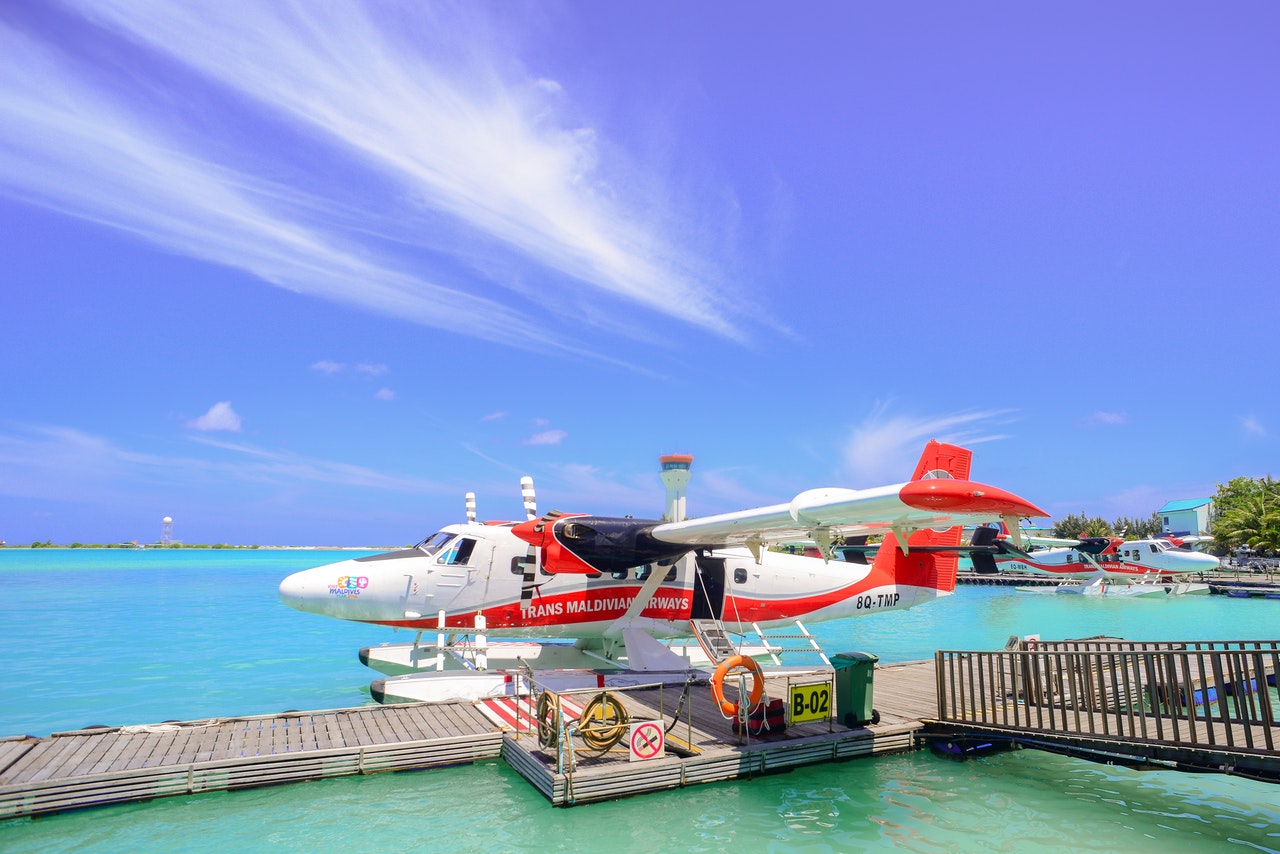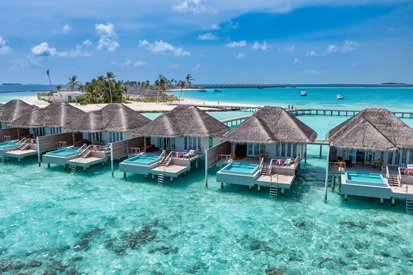September marks the end of the rainy season. This is the time when the monsoons that raged in August begin to leave the Maldives. The sky is still cloudy and brings brief downpours over the islands. Gradually, pleasant weather sets in for active recreation, snorkeling, and water sports. And most importantly, the Maldives' most beautiful inhabitants — majestic manta rays and whale sharks — return to its shores.

Depositphotos
What is the weather like in the Maldives in September?
The rainy season is ending but does not give up easily. The weather is usually warm and humid, alternating between sunny hours and occasional showers. The sea temperature remains warm — perfect for swimming and snorkeling. Compared to summer, the heat subsides, but more plankton appears, and the ocean visibility slightly improves.
- In September, the average daytime temperature in the Maldives ranges from +25°C to +30°C. Evenings and nights are usually a bit cooler — down to +23°C.
- Occasionally, sudden downpours may occur, and the southwest monsoon winds dominate, bringing heavy rain and high humidity to the atolls.
- The total rainfall in September is 243 mm. Heavy rains are expected on average 14 days throughout the month. But they pass quickly, leaving sparkling landscapes and vibrant rainbows behind. The closer to the end of the month, the clearer the skies become.

Depositphotos
How much does a holiday in the Maldives cost in September?
Fewer tourists visit the islands during this time. Beaches, resorts, and attractions are less crowded. This allows you to enjoy the beauty of the Maldives and benefit from discounts.
On average, expect to pay $30–$250 per night for guesthouses and mid-range hotels, while luxury resorts may cost $400–$1300 per night. Additionally, consider the cost of transfers from Malé to your resort island. A speedboat transfer typically costs from $65 per person, while a seaplane transfer is at least $260–$300, depending on the resort’s distance.
A one-week trip to the Maldives in September, including flights, accommodation, and transfers, can cost from $2000 to $6500 per person. It’s advisable to book flights and accommodation in advance to secure the best deals.

Depositphotos
Best places to stay in the Maldives in September
- North and South Malé, Baa Atoll: these atolls offer the widest choice of resorts, but note that in September there are on average 9–10 rainy days. Despite this, sunny periods are long enough for a comfortable stay. On Baa Atoll islands, you can spot whale sharks and manta rays during this period.
- Addu Atoll (Seenu): if you want to avoid the rain, Addu may be your best choice. There are usually no more than 8 rainy days in September, and the wind remains light (around 4 m/s). Great for water sports. Addu stands out with its history and culture, offering interesting excursions.
- Raa and Lhaviyani Atolls for a more secluded holiday. There may be slightly fewer sunny days here than in the Malé or Addu areas, and the wind is a bit stronger (around 5.5 m/s). However, air (+28–30°C) and water (+28–29°C) temperatures remain comfortable for swimming and beach leisure. These places are known for their luxury resorts and excellent diving opportunities.

Depositphotos
What to do in the Maldives in September
Treat yourself at the spa
Since heavy rains can be expected in the Maldives in September, the best way to spend time in bad weather is to enjoy relaxing spa treatments.
If you’re staying at a luxury resort, there’s a good chance they have an excellent spa offering a variety of services. Some hotels include treatments in their travel packages. A great opportunity to experience world-class spa care at discounted prices!

Emerald Maldives Resort & Spa
Go surfing
Diving in the Maldives is less popular in September due to poor underwater visibility. Surfing is a great alternative for an active holiday.
In September, consistent waves with shifting winds make the archipelago ideal for surfing. Since the Maldives lie north of Indonesia, the waves are smaller than in Bali, but more organized and predictable.
There are many surf spots in the Maldives, and most are easily accessible from any island. One of the best areas for surfing in the Maldives is the Malé Atolls, especially North Malé, home to the best waves in the islands.

Depositphotos
Watch whale sharks
Ari Atoll is one of the Maldives’ most famous spots for watching whale sharks. These giants can grow up to 12 meters long but are completely harmless to humans — they feed on plankton. Although whale sharks can be seen year-round, September is especially good, as the rainy season brings more plankton, attracting sharks closer to the surface.
Where to watch whale sharks:
- South Ari Atoll — the most popular area for diving and snorkeling with whale sharks.
- Maamigili Marine Protected Area — a protected zone where the chance of encountering sharks is especially high.
What else to do besides shark watching:
- Diving at the famous Broken Rock reef, known for its crevice and rich marine life.
- Exploring shipwrecks — for underwater history lovers.
- Romantic beach dinners at sunset.

Depositphotos
Swim with manta rays
Baa Atoll is a UNESCO Biosphere Reserve. It’s home to one of the most unique snorkeling spots in the Maldives — Hanifaru Bay. September marks the peak season for manta rays. At this time, hundreds of these creatures gather in the bay to feed — it’s an incredible sight!
Only snorkeling is allowed here, diving is strictly forbidden due to the protection of the fragile ecosystem. You can only visit with a certified guide. Since many marine animals stay close to the surface, a mask and snorkel are enough to observe them. Even beginners can enjoy encounters with mantas and whale sharks. Those wishing to dive deeper into the underwater world can take impressive photos.
Rules in Hanifaru Bay:
- Do not touch marine animals, collect corals, or leave trash.
- Flash photography is prohibited without special permission to avoid disturbing marine life.
- Keep a respectful distance — let the animals approach you.
- Stay near the surface in natural light conditions.
Due to the high popularity of the bay, plan your visit in advance — the number of permits is limited. Many hotels and dive centers offer specialized tours for watching whale sharks and mantas. An alternative is the reefs around Dharavandhoo and Dhonfanu islands, known for their abundant manta populations. You’ll also find coral gardens with many tropical fish and other marine creatures.

Depositphotos
What to wear in the Maldives in September
- Choose breathable fabrics like cotton and linen. They help keep you cool in tropical heat.
- Pack several sets of beachwear — for swimming and relaxing on the shore.
- Bring a wide-brimmed hat and sunglasses to protect yourself from the scorching sun.
- Take a light sweater or shawl for beachfront dinners under the stars. It’s warm during the day, but evenings may be slightly cooler.
- Comfortable sandals or flip-flops are a must.
- Pack a lightweight raincoat or umbrella in case of unexpected downpours.
- Waterproof clothing is recommended if you’re caught in the rain during excursions.
- Sunscreen is essential in the Maldives — even on cloudy September days, you can still get sunburned.
- Don’t forget insect repellent, especially for the evening and nighttime.
The weather in the Maldives in September may not always be ideal due to the rain, but don’t let it spoil your trip. The key is choosing a great hotel where you’ll enjoy your time regardless of the weather. You can find the best options in our Maldives catalog.

Depositphotos
More articles
- Entertainment in the Maldives: the best offers for a holiday
- What Not to Bring to the Maldives: Tourist Restrictions and Strict Entry Rules
- Alcohol in the Maldives: Is Import Permitted and Other Nuances
- What food systems are there in the Maldives: all the nuances and pitfalls
- Ferries in the Maldives: prices, routes, timetables, tips
- Hotels in Beau Vallon Seychelles
- Sun Siyam Hotels in Maldives
- Maldives Hotels with Beach Cinema
- Top 10 Beach Resorts in Seychelles 2025
- 11 Best Romantic Hotels in Seychelles



